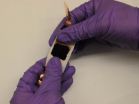(Press-News.org) At crucial points in the metabolism of all organisms, a protein with the unwieldy name of Translation Elongation Factor P (EF-P, for short) takes center stage. What it actually does during protein synthesis has only now been elucidated – by researchers at Ludwig-Maximilians-Universität in Munich.
The research group led by Kirsten Jung, Professor of Microbiology at LMU, actually focused on how bacteria cope with stress, for example how the receptor meolecule CadC monitors the acidity in the environment and alerts the cell to take countermeasures to protect itself. However, one day Kirsten Jung found herself asking questions about protein synthesis, the core biosynthetic process that makes all metabolism possible. This arose because she discovered that, in the absence of Elongation Factor P, the cell doesn't make enough CadC to carry out its job effectively.
Recovering from a stall
How then does EF-P regulate protein synthesis in general, and, in particular, the synthesis of CadC? In collaboration with Daniel Wilson's group at LMU's Gene Center, Jung's team has now teased out the mechanism. Molecular machines called ribosomes translate the genetic blueprints for proteins into the correct sequence of amino acids as they move along a messenger RNA molecule. However, when the blueprint calls for the addition of several successive proline amino acids onto the growing protein chain, the ribosomes grind to a halt. It turns out that EF-P is required to get these stalled ribosomes going again. Moreover, the factor not only fulfills this function in bacteria and in archaea, but also in the cells of eukaryotic organisms, which have their own versions of EF-P.
Jung and Wilson, who also cooperate within the context of the "Center for integrated Protein Science Munich", an Excellence Cluster, believe that the translation stop imposed by a short run of prolines provides a means of adjusting protein copy numbers in response to changing conditions. In bacteria, a functionally diverse set of around 100 proteins is known to contain such proline-rich motifs. This suggests that the stalling phenomenon indeed has a more general regulatory role, and may even provide a target for new antibiotics. Indeed, Daniel Wilson's group recently discovered the last enzyme in the EF-P modification pathway: For its rescue activity, the factor must be modified by other enzymes – which are not found in humans.
### END
Raising the blockade
2012-12-15
ELSE PRESS RELEASES FROM THIS DATE:
Physical constant passes the alcohol test
2012-12-15
This press release is available in German.
The mass ratio of protons and electrons is deemed to be a universal constant. And rightly so, as the latest radio-astronomy observations of a distant galaxy have shown. Scientists at the VU University of Amsterdam and the Max Planck Institute for Radio Astronomy in Bonn used the 100-metre radio telescope in Effelsberg to measure absorption lines of the methanol molecule at a number of characteristic frequencies. The researchers analysed the spectrum of the simplest of all the alcohols in a very distant galaxy. The result: to ...
Study questions reasons for routine pelvic exams
2012-12-15
The pelvic exam, a standard part of a woman's gynecologic checkup, frequently is performed for reasons that are medically unjustified, according to the authors of a UCSF study that may lay the groundwork for future changes to medical practice.
The research shows that many physicians mistakenly believe the exam is important in screening for ovarian cancer. The study, which surveyed obstetricians and gynecologists around the country, also shows that doctors continue to perform the exam in part because women have come to expect it.
The article is currently published online ...
New findings on killer bacteria's defence
2012-12-15
Antibodies are key to the recognition and neutralisation of bacteria by our immune system. The most common antibodies have the shape of a Y, and the two prongs fasten to molecules that belong to the bacteria. The cells in the immune system recognise the shaft and can then attack the bacteria.
Since the 1960s, it has been known that certain bacteria have developed the ability to turn these antibodies around, which makes it more difficult for the immune system to identify them. These include streptococcus bacteria, sometimes referred to as 'killer bacteria', that cause ...
More casinos does not mean more gamblers
2012-12-15
Memo to casino operators: just because you build it doesn't mean they will come.
A new study out of the University of Iowa examined how casino growth in the state has influenced gambling by residents. The survey suggests that fewer Iowans gambled overall and also that fewer people have become addicted to gambling despite a recent spurt in gaming facilities. Casino gambling was introduced in Iowa in 1991. There are currently 21 casinos in Iowa, all but three licensed by the state. (The others are owned and operated by Native American tribes.)
The findings could affect ...
Doing the right thing when things go wrong
2012-12-15
ANN ARBOR, Mich. — The University of Michigan Health System doesn't claim to be perfect. But its response to medical errors, near-misses, unexpected clinical problems and unintended outcomes is a model for the nation that other hospitals can and should copy, according to a new paper in a prestigious health care journal.
The "Michigan Model" for handling these situations, and preventing them from happening again, has not only helped patients and medical staff alike – it has also helped UMHS go against the grain of the costly, combative "deny and defend" medical malpractice ...
Stretchable electronics
2012-12-15
Electronic devices become smaller, lighter, faster and more powerful with each passing year. Currently, however, electronics such as cell phones, tablets, laptops, etc., are rigid. But what if they could be made bendable or stretchy?
According to the University of Delaware's Bingqing Wei, stretchable electronics are the future of mobile electronics, leading giants such as IBM, Sony and Nokia to incorporate the technology into their products.
Beyond traditional electronics, potential stretchable applications include biomedical, wearable, portable and sensory devices, ...
Drug to treat opioid addiction poses risks for accidental exposure to children
2012-12-15
(SALT LAKE CITY)—Buprenorphine is a safe and effective drug for treating opioid addiction. But as the prescribed use of buprenorphine has dramatically increased in recent years, accidental exposure of children to the drug has risen sharply, placing them at risk for serious injury and in extremely rare cases even death, according to researchers at the Utah Poison Control Center (UPCC), U School of Medicine's Department of Family and Preventive Health, and the Utah Department of Health (UDOH).
In a study published Thursday, Dec. 13, 2012, by the U.S. Centers for Disease ...
NASA sees Tropical Cyclone Evan batter and drench Samoan Islands
2012-12-15
NASA's Tropical Rainfall Measuring Mission or TRMM satellite continues to provide rainfall and cloud height data on powerful Cyclone Evan as it crawls through the Samoan Islands with hurricane-force winds and heavy rains. NASA's TRMM satellite identified "hot towers" in the storm, hinting that it would continue to intensify.
On Dec. 14, American Samoa, Tonga and Fiji are all under warnings or alerts as Evan continues to move west. A gale warning is in effect for Tutuila and Aunuu. A high surf warning is in effect for all of American Samoa. A flash flood watch is in effect ...
In decision-making, it might be worth trusting your gut
2012-12-15
Turns out the trope is true: You should trust your gut -- as long as you're an expert. So says a new study from researchers at Rice University, George Mason University and Boston College.
"How expert someone is within a particular domain has a positive impact on their ability to make an accurate gut decision," said Rice's Erik Dane, lead author of a study published last month in the journal Organizational Behavior and Human Decision Processes. However, he added, "Even if you're an expert, intuitive decision-making is better for some types of tasks than others. Tasks that ...
Dreidel-like dislocations lead to remarkable properties
2012-12-15
HOUSTON – (Dec. 14, 2012) – A new material structure predicted at Rice University offers the tantalizing possibility of a signal path smaller than the nanowires for advanced electronics now under development at Rice and elsewhere.
Theoretical physicist Boris Yakobson and postdoctoral fellow Xiaolong Zou were investigating the atomic-scale properties of two-dimensional materials when they found to their surprise that a particular formation, a grain boundary in metal disulfides, creates a metallic – and therefore conducting – path only a fraction of a nanometer wide.
That's ...





